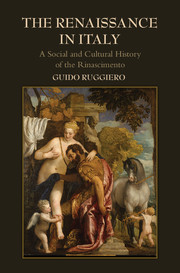Book contents
- Frontmatter
- Dedication
- Contents
- List of Illustrations
- Acknowledgments
- Maps
- Introduction: The End of the World and Its Rebirth (Rinascita) as the Rinascimento
- 1 Legitimacy: A Crisis and a Promise (c. 1250–c. 1340)
- 2 Civiltà: Living and Thinking the City (c. 1300–c. 1375)
- 3 Plague: Death, Disaster, and the Rinascita of Civiltà (c. 1325–c. 1425)
- 4 Violence: Social Conflict and the Italian Hundred Years’ War (c. 1350–1454)
- 5 Imagination: The Shared Primary Culture of the Early Rinascimento (c. 1350–c. 1475)
- 6 Courts: Princes, Aristocrats, and Quiet Glory (c. 1425–c. 1500)
- 7 Self: The Individual as a Work of Art (c. 1425–c. 1525)
- 8 Discovery: Finding the Old in the New (c. 1450–c. 1560)
- 9 Re-Dreams: Virtù, Saving the Rinascimento, and the Satyr in the Garden (c. 1500–c. 1560)
- 10 Reform: Spiritual Enthusiasms, Discipline, and a Church Militant (c. 1500–c. 1575)
- 11 Retreat: The Great Social Divide and the End of the Rinascimento (c. 1525–c. 1575)
- Epilogue: The Diaspora of the Rinascimento
- Bibliography: A Short List of Works Used
- Index
10 - Reform: Spiritual Enthusiasms, Discipline, and a Church Militant (c. 1500–c. 1575)
Published online by Cambridge University Press: 05 December 2014
- Frontmatter
- Dedication
- Contents
- List of Illustrations
- Acknowledgments
- Maps
- Introduction: The End of the World and Its Rebirth (Rinascita) as the Rinascimento
- 1 Legitimacy: A Crisis and a Promise (c. 1250–c. 1340)
- 2 Civiltà: Living and Thinking the City (c. 1300–c. 1375)
- 3 Plague: Death, Disaster, and the Rinascita of Civiltà (c. 1325–c. 1425)
- 4 Violence: Social Conflict and the Italian Hundred Years’ War (c. 1350–1454)
- 5 Imagination: The Shared Primary Culture of the Early Rinascimento (c. 1350–c. 1475)
- 6 Courts: Princes, Aristocrats, and Quiet Glory (c. 1425–c. 1500)
- 7 Self: The Individual as a Work of Art (c. 1425–c. 1525)
- 8 Discovery: Finding the Old in the New (c. 1450–c. 1560)
- 9 Re-Dreams: Virtù, Saving the Rinascimento, and the Satyr in the Garden (c. 1500–c. 1560)
- 10 Reform: Spiritual Enthusiasms, Discipline, and a Church Militant (c. 1500–c. 1575)
- 11 Retreat: The Great Social Divide and the End of the Rinascimento (c. 1525–c. 1575)
- Epilogue: The Diaspora of the Rinascimento
- Bibliography: A Short List of Works Used
- Index
Summary
Savonarola: Reform and Re-Dreams of Rebirth
One of the first reactions to the crisis of the new that inundated the Rinascimento at the turn of the sixteenth century was a traditional religious response – an appeal for reform. Once again a “re” word calling for a return, in this context to the Christianity of the early Church. As we have seen, this was a continuing refrain across the period, but it tended to grow in strength in times of crisis. Thus, although periodically across the Rinascimento fire-breathing preachers had elicited enthusiastic responses to calls for reform in the urban centers of Italy, one of the most famous, Girolamo Savonarola (1452–1498), emerged virtually in conjunction with the French invasion of Charles VIII. Called to Florence by Lorenzo de’ Medici in 1490 and made prior of the Dominican monastery there that had been rebuilt and renewed by Lorenzo’s grandfather Cosimo, Savonarola became progressively more popular and influential as a preacher as the decade progressed.
Actually, his success built on the French invasion, as he had preached well before Charles came on the scene that a “sword of God” from the north would be called to Italy to chastise the corrupt and immoral city of Florence. When Charles seemed to fulfill his prophecy, the already popular preacher, who had railed against the princely and ungodly ways of Lorenzo de’ Medici and his circle, seemed to many to be confirmed as a prophet. And in the turmoil of the rebirth of the Florentine republic following Piero’s fall, his sermons took on greater force yet, especially as they focused on traditional ways of calling for change: reform, renewal, and rebirth.
- Type
- Chapter
- Information
- The Renaissance in ItalyA Social and Cultural History of the Rinascimento, pp. 489 - 530Publisher: Cambridge University PressPrint publication year: 2014



